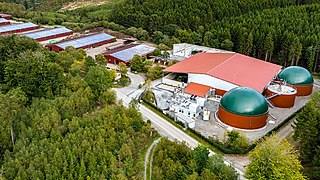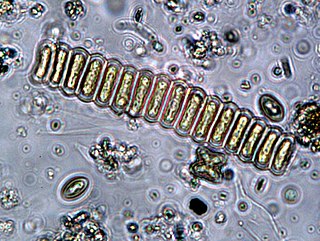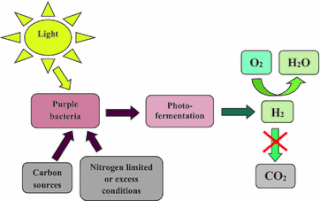Related Research Articles
Fermentation is a metabolic process whereby electrons released from nutrients are ultimately transferred to molecules obtained from the breakdown of those same nutrients.

Anaerobic digestion is a sequence of processes by which microorganisms break down biodegradable material in the absence of oxygen. The process is used for industrial or domestic purposes to manage waste or to produce fuels. Much of the fermentation used industrially to produce food and drink products, as well as home fermentation, uses anaerobic digestion.

The hydrogen cycle consists of hydrogen exchanges between biotic (living) and abiotic (non-living) sources and sinks of hydrogen-containing compounds.
Acidogenesis is the second stage in the four stages of anaerobic digestion:
Microbial metabolism is the means by which a microbe obtains the energy and nutrients it needs to live and reproduce. Microbes use many different types of metabolic strategies and species can often be differentiated from each other based on metabolic characteristics. The specific metabolic properties of a microbe are the major factors in determining that microbe's ecological niche, and often allow for that microbe to be useful in industrial processes or responsible for biogeochemical cycles.
Hydrogen gas is produced by several industrial methods. Nearly all of the world's current supply of hydrogen is created from fossil fuels. Most hydrogen is gray hydrogen made through steam methane reforming. In this process, hydrogen is produced from a chemical reaction between steam and methane, the main component of natural gas. Producing one tonne of hydrogen through this process emits 6.6–9.3 tonnes of carbon dioxide. When carbon capture and storage is used to remove a large fraction of these emissions, the product is known as blue hydrogen.
Microbial fuel cell (MFC) is a type of bioelectrochemical fuel cell system also known as micro fuel cell that generates electric current by diverting electrons produced from the microbial oxidation of reduced compounds on the anode to oxidized compounds such as oxygen on the cathode through an external electrical circuit. MFCs produce electricity by using the electrons derived from biochemical reactions catalyzed by bacteria. Comprehensive Biotechnology MFCs can be grouped into two general categories: mediated and unmediated. The first MFCs, demonstrated in the early 20th century, used a mediator: a chemical that transfers electrons from the bacteria in the cell to the anode. Unmediated MFCs emerged in the 1970s; in this type of MFC the bacteria typically have electrochemically active redox proteins such as cytochromes on their outer membrane that can transfer electrons directly to the anode. In the 21st century MFCs have started to find commercial use in wastewater treatment.

The bioconversion of biomass to mixed alcohol fuels can be accomplished using the MixAlco process. Through bioconversion of biomass to a mixed alcohol fuel, more energy from the biomass will end up as liquid fuels than in converting biomass to ethanol by yeast fermentation.
In biology, syntrophy, syntrophism, or cross-feeding is the cooperative interaction between at least two microbial species to degrade a single substrate. This type of biological interaction typically involves the transfer of one or more metabolic intermediates between two or more metabolically diverse microbial species living in close proximity to each other. Thus, syntrophy can be considered an obligatory interdependency and a mutualistic metabolism between different microbial species, wherein the growth of one partner depends on the nutrients, growth factors, or substrates provided by the other(s).

Fermentation is a type of redox metabolism carried out in the absence of oxygen. During fermentation, organic molecules are catabolized and donate electrons to other organic molecules. In the process, ATP and organic end products are formed.
Coffee wastewater, also known as coffee effluent, is a byproduct of coffee processing. Its treatment and disposal is an important environmental consideration for coffee processing as wastewater is a form of industrial water pollution.
Fed-batch culture is, in the broadest sense, defined as an operational technique in biotechnological processes where one or more nutrients (substrates) are fed (supplied) to the bioreactor during cultivation and in which the product(s) remain in the bioreactor until the end of the run. An alternative description of the method is that of a culture in which "a base medium supports initial cell culture and a feed medium is added to prevent nutrient depletion". It is also a type of semi-batch culture. In some cases, all the nutrients are fed into the bioreactor. The advantage of the fed-batch culture is that one can control concentration of fed-substrate in the culture liquid at arbitrarily desired levels.
Klebsiella aerogenes, previously known as Enterobacter aerogenes, is a Gram-negative, oxidase-negative, catalase-positive, citrate-positive, indole-negative, rod-shaped bacterium. Capable of motility via peritrichous flagella, the bacterium is approximately 1–3 microns in length.

Scenedesmus is a genus of green algae, in the class Chlorophyceae. They are colonial and non-motile. They are one of the most common components of phytoplankton in freshwater habitats worldwide.
Electrohydrogenesis or biocatalyzed electrolysis is the name given to a process for generating hydrogen gas from organic matter being decomposed by bacteria. This process uses a modified fuel cell to contain the organic matter and water. A small amount, 0.2–0.8 V of electricity is used, the original article reports an overall energy efficiency of 288% can be achieved. This work was reported by Cheng and Logan.

Photofermentation is the fermentative conversion of organic substrate to biohydrogen manifested by a diverse group of photosynthetic bacteria by a series of biochemical reactions involving three steps similar to anaerobic conversion. Photofermentation differs from dark fermentation because it only proceeds in the presence of light.
Fermentative hydrogen production is the fermentative conversion of organic substrates to H2. Hydrogen produced in this manner is often called biohydrogen. The conversion is effected by bacteria and protozoa, which employ enzymes. Fermentative hydrogen production is one of several anaerobic conversions.

A microbial electrolysis cell (MEC) is a technology related to Microbial fuel cells (MFC). Whilst MFCs produce an electric current from the microbial decomposition of organic compounds, MECs partially reverse the process to generate hydrogen or methane from organic material by applying an electric current. The electric current would ideally be produced by a renewable source of power. The hydrogen or methane produced can be used to produce electricity by means of an additional PEM fuel cell or internal combustion engine.
Microbial electrochemical technologies (METs) use microorganisms as electrochemical catalyst, merging the microbial metabolism with electrochemical processes for the production of bioelectricity, biofuels, H2 and other valuable chemicals. Microbial fuel cells (MFC) and microbial electrolysis cells (MEC) are prominent examples of METs. While MFC is used to generate electricity from organic matter typically associated with wastewater treatment, MEC use electricity to drive chemical reactions such as the production of H2 or methane. Recently, microbial electrosynthesis cells (MES) have also emerged as a promising MET, where valuable chemicals can be produced in the cathode compartment. Other MET applications include microbial remediation cell, microbial desalination cell, microbial solar cell, microbial chemical cell, etc.,.
Lutispora saccharofermentans, is an anaerobic bacteria. Lutispora saccharofermentans was first isolated from methanogenic enrichment cultures derived from a material collected from a lab-scale methanogenic landfill bioreactor.
References
- ↑ Angenent, Largus T.; Karim, Khursheed; Al-Dahhan, Muthanna H.; Wrenn, Brian A.; Domíguez-Espinosa, Rosa (September 2004). "Production of bioenergy and biochemicals from industrial and agricultural wastewater". Trends in Biotechnology. 22 (9): 477–485. doi:10.1016/j.tibtech.2004.07.001. PMID 15331229.
- ↑ Kapdan, Ilgi Karapinar; Kargi, Fikret (March 2006). "Bio-hydrogen production from waste materials". Enzyme and Microbial Technology. 38 (5): 569–582. doi:10.1016/j.enzmictec.2005.09.015.
- Chen, S.-D., Lee, K.-S., Lo, Y.-C., Chen, W.-M., Wu, J.-F., Lin, C.-Y., Chang, J.-S., 2008, "Batch and continuous biohydrogen production from starch hydrolysate by Clostridium species". International Journal of Hydrogen Energy33, 1803–12
- Dabrock, B., Bahl, H., Gottschalk, G., 1992. "Parameters affecting solvent production by Clostridium pasteurianum", Appl Environ Microbiol, 58, 1233-9
- Das, D., Veziroglu, T.N., 2001. "Hydrogen production by biological process: a survey of literature". International Journal of Hydrogen Energy26, 13-28
- Das, D., 2008, "International workshop on biohydrogen production technology" (IWBT 2008),7–9 February 2008, IIT Kharapgur. International Journal of Hydrogen Energy33, 2627-8
- Fan, Y.T, Zhang, Y.H., Zhang, S.F., Hou, H-W., Ren, B-Z., 2006. "Efficient conversion of wheat straw wastes into biohydrogen gas by cow dung compost". Biores Technol97, 500-5
- Ferchichi, M., Crabbe, E., Gwang-Hoon, G., Hintz, W., Almadidy, A., 2005. "Influence of initial pH on hydrogen production from cheese whey". J Biotechnol120, 402-9
- Idania, V.V., Richard, S., Derek, R., Noemi, R.S., Hector, M.P.V., 2005. "Hydrogen generation via anaerobic fermentation of paper mill wastes". Biores Technol96, 1907–13
- Kapdan, I. K., Kargi, F., 2006. "Bio-hydrogen production from waste materials", Enzyme Microb Technol38, 569–82
- Kim, J., Park, C., Kim, T-H., Lee, M., Kim, S., Kim, S., Seung-Wook., Lee, J., 2003. "Effects of various pretreatments for enhanced anaerobic digestion with waste activated sludge". J. Biosci. Bioeng95, 271-5
- Kraemer, J.T., Bagley, D.M., 2007. "Improving the yield from fermentative hydrogen production". Biotechnol Let29, 685–95
- Logan, B.E., 2004. Feature article: "Biologically extracting energy from wastewater: Biohydrogen production and microbial fuel cells". Environ Sci Technol38, 160A-167A
- Logan, B.E., Oh, S.E., van Ginkel, S., Kim, I.S., 2002. "Biological hydrogen production measured in batch anaerobic respirometers". Environ Sci Technol36, 2530-5
- Rai, Pankaj K, Singh, S.P & Asthana, R.K . "Biohydrogen production from cheese whey wastewater in a two-step anaerobic process". Applied Biochemistry and Biotechnology 2012, 167 (6) 1540-9
- Ren, N.Q., Chua, H., Chan, S.Y., Tsang, Y.F., Wang, Y.J., Sin, N., 2007. "Assessing optimal fermentation type for bio-hydrogen production in continuous flow acidogenic reactors", Biores Technol98, 1774–80
- Roy Chowdhury, S., Cox, D., Levandowsky, M., 1988. "Production of hydrogen by microbial fermentation". International Journal of Hydrogen Energy13, 407-10
- Shin, H.S., Youn, J.H., Kim, S.H., 2004. "Hydrogen production from food waste in anaerobic mesophilic and thermophilic acidogenesis". International Journal of Hydrogen Energy29, 1355–63
- Sparling, R., Risbey, D., Poggi-Varaldo, H.M., 1997. "Hydrogen production from inhibited anaerobic composters". International Journal of Hydrogen Energy22, 563–6
- Tang, G., Huang, J., Sun, Z., Tang, Q., Yan, C., Liu, G., 2008. "Biohydrogen production from cattle wastewater by enriched anaerobic mixed consortia: Influence of fermentation temperature and pH". J Biosci Bioengng., 106, 80-7
- Valdez-Vazquez, I., Rıos-Leal, E., Munoz-Paez, K.M., Carmona-Martınez, A., Poggi-Varaldo, H.M., 2006. "Effect of inhibition treatment, type of Inocula, and incubation temperature on batch H2 production from organic solid waste". Biotechnol Bioeng95, 342-9
- van Ginkel, S.W., Oh, S.E., Logan. B. E., 2005. "Biohydrogen gas production from food processing and domestic wastewaters". International Journal of Hydrogen Energy30, 1535–42
- Venkata Mohan, S., Vijaya Bhaskar, Y., Sarm, P.N., 2007a. "Biohydrogen production from chemical wastewater treatment by selectively enriched anaerobic mixed consortia in biofilm configured reactor operated in periodic discontinuous batch mode". Water Res41, 2652–64
- Venkata Mohan, S., Mohanakrishna G., Veer Raghuvulu S., Sarma, P.N., 2007b. "Enhancing biohydrogen production from chemical wastewater treatment in anaerobic sequencing batch biofilm reactor (AnSBBR) by bioaugmenting with selectively enriched kanamycin resistant anaerobic mixed consortia". International Journal of Hydrogen Energy32, 3284–92
- Venkata Mohan, S., Lalit Babu, V., Sarma, P.N., 2007c. "Anaerobic biohydrogen production from dairy wastewater treatment in sequencing batch reactor (AnSBR): Effect of organic loading rate". Enzyme and Microbial Technology41(4), 506-15
- Venkata Mohan, S., Bhaskar, Y.B., Krishna, T.M., Chandrasekhara Rao N., Lalit Babu V., Sarma, P.N., 2007d. "Biohydrogen production from chemical wastewater as substrate by selectively enriched anaerobic mixed consortia: Influence of fermentation pH and substrate composition". International Journal of Hydrogen Energy, 32, 2286–95
- Venkata Mohan, S., Mohanakrishna, G., Ramanaiah, S.V, Sarma, P.N., 2008a. "Simultaneous biohydrogen production and wastewater treatment in biofilm configured anaerobic periodic discontinuous batch reactor using distillery wastewater". International Journal of Hydrogen Energy33(2), 550-8
- Venkata Mohan, S., Mohanakrishna, G., Ramanaiah, S.V, Sarma, P.N., 2008b. "Integration of acidogenic and methanogenic processes for simultaneous production of biohydrogen and methane from wastewater treatment". International Journal of Hydrogen Energy33, 2156–66
- Venkata Mohan, S., Lalit Babu, V., Sarma, P.N., 2008c. "Effect of various pre-treatment methods on anaerobic mixed microflora to enhance biohydrogen production utilizing dairy wastewater as substrate". Biores Technol99, 59-67
- Venkata Mohan, S., Lalit Babu, V., Srikanth, S., Sarma, P.N., 2008d. "Bio-electrochemical behavior of fermentative hydrogen production process with the function of feeding pH". International Journal of Hydrogen Energy doi : 10.1016/j.ijhydene.2008.05.073
- Venkata Mohan, S., Srikanth, S., Dinakar, P., Sarma, P.N., 2008e. "Photo-biological hydrogen production by the adopted mixed culture: Data enveloping analysis". International Journal of Hydrogen Energy33(2), 559-69
- Venkata Mohan, S., Mohanakrishna, G., Reddy, S.S., Raju, B.D., Rama Rao, K.S., Sarma, P, N., 2008f. "Self-immobilization of acidogenic mixed consortia on mesoporous material (SBA-15) and activated carbon to enhance fermentative hydrogen production". International Journal of Hydrogen Energy doi : 10.1016/j.ijhydene.2008.07.096
- Vijaya Bhaskar, Y., Venkata Mohan S, Sarma, P.N., 2008. "Effect of substrate loading rate of chemical wastewater on fermentative biohydrogen production in biofilm configured sequencing batch reactor". Biores Technol99, 6941–8
- Vijayaraghavan, K., Ahmad, D., "Biohydrogen generation from palm oil mill effluent using anaerobic contact filter". International Journal of Hydrogen Energy31, 1284–91
- Yu, H., Zhu, Z., Hu, W., Zhang, H., 2002. "Hydrogen production from rice winery wastewater in an upflow anaerobic reactor by using mixed anaerobic cultures", International Journal of Hydrogen Energy27, 1359–65
- Zhang, T., Liu, H., Fang, H.H.P., 2003. "Biohydrogen production from starch in wastewater under thermophilic condition". J Environ Manag69, 149-56
- Zhu, H., Beland, M., 2006, "Evaluation of alternative methods of preparing hydrogen producing seeds from digested wastewater sludge". International Journal of Hydrogen Energy31, 1980-8